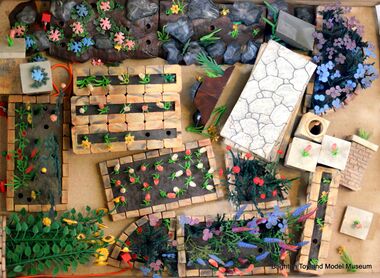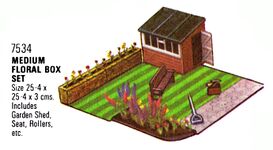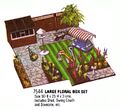Category:Britains Floral Garden
| Toy Brands and Manufacturers |
|---|
Britains Floral Garden |
| 1960 - 1970 |
| Britains - Circus - Farm - Floral - Garden - Zoo |
1960s: Floral Miniature garden, fold-out leaflet, rear panel [image info]
1960s: Floral Miniature garden, fold-out leaflet, front panel [image info]
Miscellaneous flowerbeds [image info]
Flower beds [image info]
1996 catalogue image: Pergola and Roses [image info]
1996 catalogue image: Pergola and Roses [image info]
1996 catalogue image: Brick edging [image info]
The Museum has now finished building a lovely new BFG diorama, which is now on display
Britains Floral Garden (1960 - late 1970) was Britains' 1960s' reimagining of the earlier lead-based Britains Miniature Gardening range, redesigned to be manufactured in plastic. The range was designed and sculpted by the talented Roy Selwyn-Smith (1923-2006).
Promotional text:
For Father
By using the miniature garden he can plan out his real garden in a thoroughly practical manner from the laying out of the flower beds, crazy paving paths, lawn, pergolas, etc., and filling it with a large yariety of plants in full flower, arranging and rearranging his design in miniature until a satisfactory one has been reached.
For Mother
Mother will also want to have her turn with this versatile and beautiful construction set. As home decoration or table centres, all kinds of attractive effects can be devised; and without the trouble and expense of growing or using real miniature plants.
The ingenious housewife will devise many delightful ways of using these miniature flowers as cake decorations for those important occasions.
Professionally
The Floral garden can go to work too. The perfect detail of these models will transform all kinds of architectural and other displays. They can be used in planning real horticultural exhibitions and large garden lay-outs for nurserymen who can submit them for their client's approval. As a shop window display for the seedsman or a special attraction in the gardening department of stores, the uses are innumerable.
Building up your garden
From a modest start with one flower packet (a small garden in itself) you can build your Floral garden into as large and varied model as you like with the various packets of flowers and accessories obtainable from your local stockists. The list on the back of this booklet shows the items in the present range but more will continually be added to the series.
— , Britains Ltd, , How to Plan and Plant your own Garden, , 1961?
You can make an endless variety of Garden layouts with this wonderful series. These box sets show some of the arrangements you can assemble but with a simple system of "one price" packets of flowers and accessories you can extend your garden to any size. With no painting or gluing it has a unique appeal to girls as well as boys and can be of great assistance in domestic and professional planning.
— , Britains Ltd., , Britains catalogue, , 1966
Innovations
The "planter"
While the basic idea, range and designs were mostly closely based on the earlier 1930s lead range, the design of the flowers and flowerbeds needed rethinking. In the lead range, flowers had been cast and supplied flat, and the owner could then bend them into more realistic shapes. This idea didn't work in soft plastic, which wouldn't subsequently "take a shape" after moulding, and would tend to "bounce back" into its original shape given the chance. How could one recreate the dense internal detail and structure of a bush or branching plant in a way that was compatible with the demands of injection moulding?
The solution that allowed Britains to finally recreate a plastic version of Britains Garden was quite ingenious. Each plant was moulded as a flat "starlike" set of leaves and stalks radiating away from a central plastic "nub" in all directions. The "nub" was placed in a flowerbed planting hole, and a special "planting tool", whose shaft and handle were made to look like a garden spade, was then used to force the nub deeper into the hole. As the bottoms of the stems entered the hole, the radiating set of foliage suddenly bunched together at the base and perked up to form a spray of foliage, "springing to life" in a very satisfying manner.
The lack of predictability for how this bunching happened added an extra degree of randomness to the plants, and if a stem or two occasionally broke off after repeated replanting, this added even more natural-looking variation to a flowerbed.
Where the earlier lead flowers had been painted, the new plastic versions used pre-coloured plastic, with the material's natural translucency adding more realism. Flower-heads were separately moulded in appropriately-coloured plastic, singly or in offset clusters, and push-fitted onto the stems by the user, which gave even more natural variation to the resulting plants.
"Brick" borders
Flowerbeds could be bordered by low brick walls composed of three staggered courses of flattened brick. In reality, these walls were made of Y-shaped triple-brick pieces that clipped together to form straight walls, or curves, or right-angle joints.
This was a brilliant idea for three reasons: the lack of strict locating points meant that the shape of the walls ended up with a natural-looking "rustic" variation, the use of a streaked mixture of plastics meant that there was a colour variation looking like stone, which was broken up at the Y-boundaries, making it look as if each brick was different (if the walls had been moulded as a single piece, the whole wall would share the same colour-variation and streaking and look less real) ... and thirdly, by having the user build the walls themselves, this added even more play value to the sets, and more of a sense of personal achievement at the sight of a finished garden.
Popularity
The way that the flowers "came alive" when planted enthralled many children, and while "Floral Garden" doesn't seem to have been a huge seller, it was so different from other toys of the period that owners who spent many happy childhood hours, planting and rearranging their plastic gardens are now fiercely loyal when it comes to any mention of the range, and there is a healthy second-hand market for the 1960s-produced parts and accessories.
Range
The listing below is drawn from our collection of 1960s Britains catalogues. There maybe additional sets, or items not listed here that were "garden-y", but technically part of other ranges.
Plants
- 2534 Assorted Flowers Only
- 2535 Crocus and Snowdrops
- 2537 Hyacinths
- 2538 Tulips and Daffodils
- 2539 Lupins and Delphiniums
- 2542 4 Sunflowers and 5 Hollyhocks
- 2543 3 Rhododendron Bushes
- 2544 12 Gladioli
- 2545 6 Assorted Asters
- 2546 3 Climbing Roses
- 2547 3 Rose Bushes and 3 Standard Roses
- 2552 Beans, Cabbages, Sprouts
- 2553 Lettuces, Marrows, Peas
Hardware
- 2560 Brick Edging
- 2568 Lawn
- 2569 Crazy Paving
- 2572 Rock Pool
- 2573 Rockery
- 2584 Pergola and Roses
- 2585 Garden Walls
- 2586 Garden Fencing
- 2587 Stone Cornerpost and Iron Fencing
- 2590 Garden Shed
- 2591 Cold Frame , With pots, plants and seed boxes, etc
- 2592 Greenhouse
- 2594 Lawn Mower and Hose
- 2595 Garden Roller and Wheelbarrow
- 2597 Swing Couch
- 2598 Garden Furniture
- 2600 Weeping Willow
Boxed Sets
- 7531 Junior Floral Box Set
- 7532 Junior Floral Box Set
- 7533 Junior Floral Box Set
- 7534 Medium Floral Box Set
- 7535 Medium Floral Box Set
- 7536 Medium Floral Box Set
- 7537 Medium Floral Box Set
- 7538 Medium Floral Box Set
- 7543 Large Floral Box Set
- 7544 Large Floral Box Set
- 7545 Large Floral Box Set
- 7546 Large Floral Box Set
Lucy's Garden / Lucy's Little Garden
1978: Lucy's Little Garden 7180: A model garden with flowers and beds, tree and wall (introduced 1976) [image info]
1978: Lucy's Garden Packs 7182 (introduced 1977) [image info]
In 1976, an attempt was made at a limited relaunch of the Floral Garden range, renamed Lucy's Little Garden (a.k.a. Lucy's Garden / Lucy's Mini Garden), with a garden pack appearing in 1976, and extra accessory packs in 1977. However, these took up less than a page in the 1978 catalogue.
This can probably be seen as an attempt to follow the lead of other toy manufacturers who had rebranded old ranges in an attempt to "personalise" them, notably Tri-ang's renaming of the Spot-On Dollhouse furniture range as Jennys Home.
See also:
- Britains Miniature Gardening – the range's 1930s lead-based predecessor
External links
- Floral Garden, Britains Ltd. (collections.vam.ac.uk)
- My Floral Garden People (letstalk24.co.uk)
- Celia's Virtual Toy Museum: My toys from the 1960s (celiasvirtualtoymuseum.wordpress.com)
- Create a garden/Britain's Floral Garden? (forums.doyouremember.co.uk)
- Britains - Floral Garden Range - Retailer Display (vectis.co.uk)
- Obituary: Roy Selwyn-Smith (theguardian.com)
Subcategories
This category has the following 4 subcategories, out of 4 total.
B
- Britains Floral Garden (display) (16 P, 18 F)
M
- Make-Up Tree Models (Britains) (5 P, 14 F)
Pages in category ‘Britains Floral Garden’
The following 20 pages are in this category, out of 20 total.
B
C
G
- Garden Fences (Britains Floral Garden 2586)
- Garden Furniture (Britains Floral Garden 2598)
- Garden Roller and Wheelbarrow (Britains Floral Garden 2595)
- Garden Shed (Britains Floral Garden 2590)
- Garden Swing Couch, boxed (Britains Floral Garden 2597)
- Garden Walls (Britains Floral Garden 2585)
- Greenhouse (Britains Floral Garden 2592)
- Greenhouse, boxed (Britains Floral Garden 2592)
Media in category ‘Britains Floral Garden’
The following 90 files are in this category, out of 90 total.
- Hyacinths, Britains Floral Garden 2537 (Britains 1966).jpg 673 × 480; 45 KB
- Sunflowers and Hollyhocks, Britains Floral Garden 2542 (Britains 1966).jpg 765 × 1,083; 107 KB
- Rhododendron Bushes, Britains Floral Garden 2543 (Britains 1966).jpg 701 × 559; 75 KB
- Gladioli, Britains Floral Garden 2544 (Britains 1966).jpg 688 × 587; 64 KB
- Assorted Asters, Britains Floral Garden 2545 (Britains 1966).jpg 682 × 556; 66 KB
- Climbing Roses, Britains Floral Garden 2546 (Britains 1966).jpg 760 × 883; 105 KB
- Brick Edging, Britains Floral Garden 2560 (Britains 1966).jpg 630 × 586; 67 KB
- Lawn, Britains Floral Garden 2568 (Britains 1966).jpg 870 × 671; 70 KB
- Crazy Paving, Britains Floral Garden 2569 (Britains 1966).jpg 572 × 512; 50 KB
- Rock Pool, Britains Floral Garden 2572 (Britains 1966).jpg 779 × 857; 107 KB
- Rockery, Britains Floral Garden 2573 (Britains 1966).jpg 813 × 726; 93 KB
- Pergola and Roses, Britains Floral Garden 2584 (Britains 1966).jpg 707 × 723; 82 KB
- Garden Walls, Britains Floral Garden 2585 (Britains 1966).jpg 620 × 531; 56 KB
- Garden Fences, Britains Floral Garden 2586 (Britains 1966).jpg 534 × 637; 77 KB
- Garden Shed, Britains Floral Garden 2590 (Britains 1966).jpg 692 × 740; 101 KB
- Cold Frame, Britains Floral Garden 2591 (Britains 1966).jpg 724 × 695; 82 KB
- Greenhouse, Britains Floral Garden 2592 (Britains 1966).jpg 780 × 748; 107 KB
- Lawn Mower and Hose, Britains Floral Garden 2594 (Britains 1966).jpg 853 × 798; 86 KB
- Swing Couch, Britains Floral Garden 2597 (Britains 1966).jpg 742 × 750; 100 KB
- Garden Furniture, Britains Floral Garden 2598 (Britains 1966).jpg 705 × 647; 76 KB
- Weeping Willow, Britains Floral Garden 2600 (Britains 1966).jpg 592 × 857; 77 KB
- Greenhouse, Britains Floral Garden, Box Set 4531 (Britains 1970).jpg 683 × 776; 100 KB
- Rockery, Britains Floral Garden, Box Set 4532 (Britains 1970).jpg 877 × 637; 81 KB
- Rock Pool, Britains Floral Garden, Box Set 4533 (Britains 1970).jpg 866 × 706; 75 KB
- Swing Couch, Britains Floral Garden, Box Set 4534 (Britains 1970).jpg 792 × 816; 114 KB
- Garden Shed Set, Britains Floral Garden 4536 (Britains 1970).jpg 792 × 872; 95 KB
- Britains Folk, family group (Britains Floral Garden 7530).jpg 3,000 × 1,838; 462 KB
- Britains Folk, from above (Britains Floral Garden 7530).jpg 1,600 × 1,067; 268 KB
- Junior Floral Box Set, Britains Floral Garden 7531 (Britains 1966).jpg 955 × 760; 201 KB
- Junior Floral Box Set, Britains Floral Garden 7532 (Britains 1966).jpg 954 × 1,154; 167 KB
- Junior Floral Box Set, Britains Floral Garden 7533 (Britains 1966).jpg 1,289 × 722; 161 KB
- Medium Floral Box Set, Britains Floral Garden 7534 (Britains 1970).jpg 1,380 × 759; 147 KB
- Medium Floral Box Set, Britains Floral Garden 7535 (Britains 1970).jpg 1,362 × 876; 158 KB
- Medium Floral Box Set, Britains Floral Garden 7536 (Britains 1966).jpg 1,288 × 1,065; 236 KB
- Medium Floral Box Set, Britains Floral Garden 7537 (Britains 1966).jpg 1,361 × 867; 216 KB
- Medium Floral Box Set, Britains Floral Garden 7538 (Britains 1966).jpg 1,435 × 1,055; 234 KB
- Large Floral Box Set, Britains Floral Garden 7543 (Britains 1970).jpg 1,752 × 1,161; 293 KB
- Large Floral Box Set, Britains Floral Garden 7544 (Britains 1970).jpg 1,310 × 1,205; 242 KB
- Large Floral Box Set, Britains Floral Garden 7545 (Britains 1966).jpg 1,563 × 1,037; 265 KB
- Large Floral Box Set, Britains Floral Garden 7546 (Britains 1966).jpg 1,517 × 1,089; 271 KB
- Aerial view, Britains Floral Garden display (BTMM 2021).jpg 3,000 × 781; 534 KB
- Bench, Britains Floral Garden (BTMM 2021).jpg 1,200 × 800; 429 KB
- Brick Edging, Britains Floral Garden (BTMM 2021).jpg 3,000 × 2,000; 1.27 MB
- Britains Floral Garden display (1990s).jpg 1,516 × 1,800; 593 KB
- Britains Floral Garden, storage box 1.jpg 3,000 × 2,194; 1.29 MB
- Britains Floral Garden, storage box 2, side view.jpg 3,000 × 2,000; 745 KB
- Britains Floral Garden, storage box 2.jpg 3,000 × 2,365; 1.11 MB
- Britains Floral Garden, storage box 3.jpg 3,000 × 2,032; 1,014 KB
- Britains Floral Garden, storage box 4, end view.jpg 3,000 × 2,000; 636 KB
- Britains Floral Garden, storage box 4, side view.jpg 3,000 × 1,773; 819 KB
- Britains Floral Garden, storage box 4.jpg 3,000 × 1,998; 1.11 MB
- Britains Floral Garden, storage box 5.jpg 3,000 × 1,515; 634 KB
- Cold Frames, Britains Floral Garden (BTMM 2021).jpg 1,200 × 800; 490 KB
- Fence, Britains Floral Garden (BTMM 2021).jpg 1,200 × 800; 490 KB
- Floral Family Group set 7530 (BritainsCat 1967).jpg 1,106 × 929; 208 KB
- Floral Miniature Garden, Britains (BFGLeaflet 1960s).jpg 1,800 × 1,220; 307 KB
- Floral Miniature Garden, by Britains Ltd (BFGLeaflet 1960s).jpg 1,800 × 1,188; 372 KB
- Floral Miniature Garden, Flower Packets (Britains 1966).jpg 1,019 × 559; 94 KB
- Floral Miniature Garden, pack (Britains 1966).jpg 826 × 1,116; 162 KB
- Flower bed detail (Britains Floral Garden).jpg 3,000 × 2,000; 939 KB
- Flower Beds, Britains Floral Garden (Britains 1966).jpg 741 × 692; 98 KB
- Garden Furniture, Britains Floral Garden display (BTMM 2021).jpg 1,200 × 800; 492 KB
- Garden Hose, Britains Floral Garden (BTMM 2021).jpg 1,200 × 800; 497 KB
- Garden Roller, Britains Floral Garden (BTMM 2021).jpg 1,200 × 800; 456 KB
- Garden Shed, Britains Floral Garden (BTMM 2021).jpg 1,200 × 800; 542 KB
- Greenhouse, Britains Floral Garden (BTMM 2021).jpg 2,000 × 1,334; 1.31 MB
- Iron Gates, Britains Floral Garden display (BTMM 2021).jpg 3,000 × 2,000; 1.56 MB
- Lucys Garden Packs, Britains 7182 (BritCat 1978).jpg 940 × 1,200; 246 KB
- Lucys Little Garden Pack, Britains 7180 (BritCat 1978).jpg 2,096 × 1,247; 538 KB
- Make-up Tree Models, Britains (BFGLeaflet 1960s).jpg 1,800 × 1,188; 327 KB
- Pergola, Britains Floral Garden (BTMM 2021).jpg 3,000 × 2,000; 1.26 MB
- Planting Tool (Britains Floral Garden).jpg 2,000 × 665; 68 KB
- Planting, Pond, Britains Floral Garden (BTMM 2021).jpg 3,000 × 2,000; 1.31 MB
- Planting, The Floral Miniature Garden Series, Britains (BFGLeaflet 1960s).jpg 1,800 × 915; 270 KB
- Rockery, Britains Floral Garden (BTMM 2021).jpg 2,400 × 1,600; 1.83 MB
- So Easy to Plant, Britains Floral Garden (Britains 1966).jpg 996 × 899; 106 KB
- Stone Wall corner, Britains Floral Garden display (BTMM 2021).jpg 1,600 × 1,067; 701 KB
- Stone Wall, Britains Floral Garden (BTMM 2021).jpg 3,000 × 2,000; 931 KB
- Sunflowers, Britains Floral Garden (BTMM 2021).jpg 1,200 × 800; 524 KB
- Tools, Britains Floral Garden (BTMM 2021).jpg 3,000 × 2,000; 942 KB
























































































































































